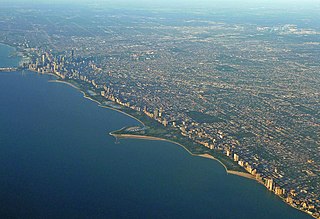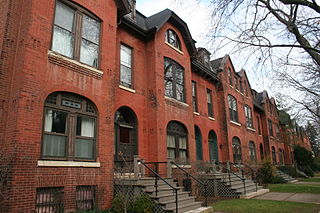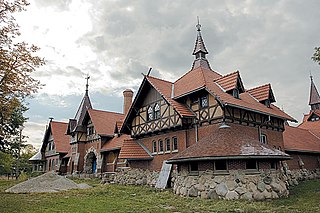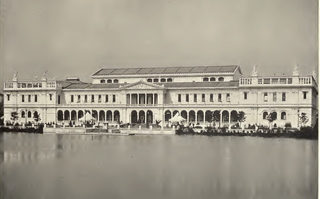
Jackson Park is a 500-acre (2 km²) park located at 6401 South Stony Island Avenue in the Woodlawn community on the South Side in Chicago, Illinois. It extends into the South Shore and Hyde Park nearby neighborhoods, bordering onto Lake Michigan and several other South Side neighborhoods. Named for Seventh President Andrew Jackson, it is one of two Chicago Park District parks with the name "Jackson", the other being Mahalia Jackson Park for the gospel music singer in the Auburn Gresham community on the far southwest side of Chicago.

Lincoln Park is a 1,208-acre (489-hectare) park situated along Lake Michigan on the North Side of Chicago, Illinois. Named after US President Abraham Lincoln, it is the city's largest public park and stretches for seven miles (11 km) from Grand Avenue on the south to near Ardmore Avenue on the north, just north of the Lake Shore Drive terminus at Hollywood Avenue. Several museums and a zoo are located between North Avenue and Diversey Parkway in the eponymous neighborhood. Further to the north, the park is characterized by parkland, beaches, recreational areas, nature reserves, and harbors. To the south, there is a more narrow strip of beaches east of Lake Shore Drive, almost to downtown. With 20 million visitors per year, Lincoln Park is the second-most-visited park in the United States.
Marshall Field's was a department store in Chicago, Illinois, that grew to become a chain before being acquired by Macy's, Inc in 2005.

State Street is a large south-north street in Chicago, Illinois, USA and its south suburbs. It begins at North Avenue, the south end of Lincoln Park, runs south through the heart of Downtown Chicago, and ends at the southern city limits, intersecting 127th Street along the bank of the Little Calumet River. It resumes north of 137th Street in Riverdale and runs south intermittently through Chicago's south suburbs until terminating at New Monee Road in Crete, Illinois. Its intersection with Madison Street has marked the base point for Chicago's address system since 1909.

Museum Campus is a 57-acre (23 ha) park in Chicago that sits alongside Lake Michigan in Grant Park and encompasses five of the city's most notable attractions: the Adler Planetarium, America's first planetarium; the Shedd Aquarium; the Field Museum of Natural History; Soldier Field, home of the NFL Chicago Bears football team; and the Lakeside Center of McCormick Place. Museum Campus sits adjacent to Northerly Island along the waterfront.

Marquette Park, the largest park on the southwest side of Chicago, Illinois, at 323 acres (1.31 km2), is located at 41.768°N 87.703°W in the city's Chicago Lawn neighborhood. The park is named for Father Jacques Marquette (1637–1675).
The Rayen School was a public high school in Youngstown, Ohio, United States. At the time it was closed in 2007, it was the oldest of the three high schools in the city. The high school's most recent physical plant opened in 1923, when the institution was relocated from a 19th-century structure located at 120 W Wood Street in Youngstown that currently houses Youngstown's Board of Education.
Bessemer Park is a public park in Chicago, Illinois, U.S.A. Created in 1904, it was named for Henry Bessemer, the inventor of the eponymous steelmaking process. The name is appropriate, since Chicago's most productive steel mill, the U.S. Steel Southworks, was located just a mile away.

The McCormick Row House District is a group of houses located in the Lincoln Park community area in Chicago, Illinois, USA. It sits between East and West parts of DePaul University's Lincoln Park Campus and is independent from the school. They were built between 1884 and 1889 and used by the McCormick Theological Seminary to gain rental income. They were designed in the Queen Anne Style by the A. M. F. Colton and Son architects and joined the list of Chicago Landmarks May 4, 1971. The McCormick Row House District also lies within the boundaries of the Sheffield Historic District.

Douglas Park is a large Chicago Park District park that serves as a cultural and community center on the West Side of Chicago, Illinois. It is named after the U.S. Senator Stephen A. Douglas. Originally named South Park, its 173 acres (0.70 km2) are in the North Lawndale community area with an official address of 1401 S. Sacramento Drive.

The Chicago Avenue Pumping Station is a historic district contributing property in the Old Chicago Water Tower District landmark district. It is located on Michigan Avenue along the Magnificent Mile shopping district in the Near North Side community area of Chicago, Illinois. It is on the east side of Michigan Avenue opposite the Chicago Water Tower.

The Palliser's Cottage Home No. 35 is a Stick Style house at 2314 West 111th Place in the Morgan Park neighborhood of Chicago, Illinois, United States. Plans for the house appeared in the pattern book of Palliser, Palliser & Co. in 1878 and this house was built in 1882 for Rev. Johan Edgren. It was designated a Chicago Landmark on February 16, 2000.

Jobbers Canyon Historic District was a large industrial and warehouse area comprising 24 buildings located in downtown Omaha, Nebraska, USA. It was roughly bound by Farnam Street on the north, South Eighth Street on the east, Jackson Street on the south, and South Tenth Street on the west. In 1989, all 24 buildings in Jobbers Canyon were demolished, representing the largest National Register historic district loss to date.

Loop Retail Historic District is a shopping district within the Chicago Loop community area in Cook County, Illinois, United States. It is bounded by Lake Street to the north, Ida B. Wells Drive to the south, State Street to the west and Wabash Avenue to the east. The district has the highest density of National Historic Landmark, National Register of Historic Places and Chicago Landmark designated buildings in Chicago. It hosts several historic buildings including former department store flagship locations Marshall Field and Company Building, and the Sullivan Center. It was added to the National Register of Historic Places on November 27, 1998. It includes 74 contributing buildings and structures, including 13 separately listed Registered Historic Places, and 22 non-contributing buildings. Other significant buildings in the district include the Joffrey Tower, Chicago Theatre, Palmer House, and Page Brothers Building. It also hosts DePaul University's College of Commerce, which includes the Kellstadt Graduate School of Business and the Robert Morris College.

The Cultural Center Historic District is a historic district located in Midtown Detroit, Michigan, which includes the Art Center : the Detroit Public Library, the Detroit Institute of Arts, and the Horace H. Rackham Education Memorial Building were listed on the National Register of Historic Places in 1983. The district contains several cultural attractions.

Prairie Avenue is a north–south street on the South Side of Chicago, which historically extended from 16th Street in the Near South Side community area of Chicago in Cook County, Illinois, United States, to the city's southern limits and beyond. The street has a rich history from its origins as a major trail for horseback riders and carriages. During the last three decades of the 19th century, a six-block section of the street served as the residence of many of Chicago's elite families and an additional four-block section was also known for grand homes. The upper six-block section includes part of the historic Prairie Avenue District, which was declared a Chicago Landmark and added to the National Register of Historic Places.

Sherman Park is a sixty-acre park in the New City neighborhood of South Side, Chicago.

The National Museum of Puerto Rican Arts and Culture is a museum in Chicago dedicated to interpreting the arts and culture of the Puerto Rican people and of the Puerto Ricans in Chicago. Founded in 2001, it is housed in the historic landmark Humboldt Park stables and receptory, near the Paseo Boricua. It hosts visual arts exhibitions, community education, and festivals. Its exhibitions have featured the artwork of Osvaldo Budet, Elizam Escobar, Antonio Martorell, Ramon Frade Leon, and Lizette Cruz, in addition to local Chicago or Puerto Rican artists. The Institute also sponsors music events including an annual Navi-Jazz performance, described as a "fusion of Puerto Rican and African American musical elements."

Independence Park, officially Park #83 of the Chicago Park District, is a 7.16-acre (2.90 ha) recreational area in the Irving Park neighborhood of North Side, Chicago, Illinois.

The Woman's Building was designed and built for the World's Columbian Exposition held in Chicago in 1893. It had exhibition space as well as an assembly room, a library, and a Hall of Honor. The History of the World's Fair states, "It will be a long time before such an aggregation of woman's work, as may now be seen in the Woman's Building, can be gathered from all parts of the world again."






























